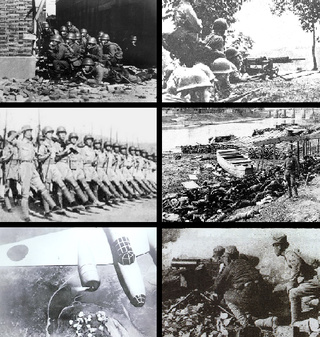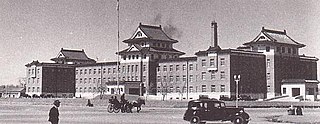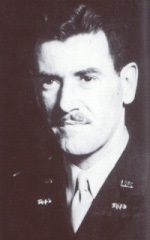Related Research Articles

Biological warfare, also known as germ warfare, is the use of biological toxins or infectious agents such as bacteria, viruses, insects, and fungi with the intent to kill, harm or incapacitate humans, animals or plants as an act of war. Biological weapons are living organisms or replicating entities. Entomological (insect) warfare is a subtype of biological warfare.

Unit 731, short for Manshu Detachment 731 and also known as the Kamo Detachment and the Ishii Unit, was a covert biological and chemical warfare research and development unit of the Imperial Japanese Army that engaged in lethal human experimentation and biological weapons manufacturing during the Second Sino-Japanese War (1937–1945) and World War II. It killed an estimated 200,000 to 300,000 people. It was based in the Pingfang district of Harbin, the largest city in the Japanese puppet state of Manchukuo and had active branch offices throughout China and Southeast Asia.

The International Military Tribunal for the Far East (IMTFE), also known as the Tokyo Trial and the Tokyo War Crimes Tribunal, was a military trial convened on 29 April 1946 to try leaders of the Empire of Japan for their crimes against peace, conventional war crimes, and crimes against humanity, leading up to and during the Second World War. The IMTFE was modeled after the International Military Tribunal (IMT) at Nuremberg, Germany, which prosecuted the leaders of Nazi Germany for their war crimes, crimes against peace, and crimes against humanity.

Vice-Admiral Jisaburō Ozawa was an admiral in the Imperial Japanese Navy during World War II. Ozawa held several important commands at sea throughout the duration of the conflict.

Men Behind the Sun is a 1988 Hong Kong historical exploitation horror film directed by T. F. Mou, and written by Mei Liu, Wen Yuan Mou and Dun Jing Teng. The film is a graphic depiction of the war atrocities committed by the Imperial Japanese Army at Unit 731, the secret biological weapons experimentation unit of the Imperial Japanese Army during the Second Sino-Japanese War. It details the various cruel medical experiments Unit 731 conducted on Chinese and Siberian prisoners towards the end of the war.
Zhongma Fortress — also Zhong Ma Prison Camp or Unit Tōgō — was a prison camp where the Japanese Kwantung Army carried out covert biological warfare research on human test subjects. Built in Beiyinhe, outside of Harbin, Manchukuo during the Second Sino-Japanese War, the camp served as a center for human subject experimentation and could hold up to 1,000 prisoners at any given time. In 1937 the prison camp was destroyed and testing operations were transferred to Pingfang under Unit 731.

Surgeon General Shirō Ishii was a Japanese war criminal, microbiologist and army medical officer who was the director of Unit 731, a biological warfare unit of the Imperial Japanese Army. Ishii led the development and application of biological weapons at Unit 731 in Manchukuo during the Second Sino-Japanese War from 1937 to 1945, including the bubonic plague attacks at Chinese cities of Changde and Ningbo, and planned the Operation Cherry Blossoms at Night biological attack against the United States.

War crimes in Manchukuo were committed during the rule of the Empire of Japan in northeast China, either directly, or through its puppet state of Manchukuo, from 1931 to 1945. Various war crimes have been alleged, but have received comparatively little historical attention.

The Kaimingjie germ weapon attack was a Japanese biological warfare bacterial germ strike against Kaimingjie, an area of the port of Ningbo in the Chinese province of Zhejiang in October 1940, during the Second Sino-Japanese War.
Unit Ei 1644 — also known as Unit 1644, Detachment Ei 1644, Detachment Ei, Detachment Tama, The Nanking Detachment, or simply Unit Ei, was a Japanese laboratory and biological warfare facility under control of the Epidemic Prevention and Water Purification Department. It was established in 1939 in Japanese-occupied Nanjing as a satellite unit of Unit 731. It had 12 branches and employed about 1,500 men.

Beginning in the mid-1930s, Japan conducted numerous attempts to acquire and develop weapons of mass destruction. The 1943 Battle of Changde saw Japanese use of both bioweapons and chemical weapons, and the Japanese conducted a serious, though futile, nuclear weapon program.

Prince Tsuneyoshi Takeda was the second and last heir of the Takeda-no-miya collateral branch of the Japanese Imperial Family.
The Epidemic Prevention and Water Purification Department was a department of the Imperial Japanese Army from 1936 to the dissolution of the Army in 1945. While its public mission was to prevent the spread of disease and monitor water supply, several field armies also assigned units the mission of manufacturing biological weapons. Many units also performed unethical human experimentation, such as Unit 731, in which thousands of prisoners of war and civilians were tortured to death over the course of years.

Allegations that the United States military used biological weapons in the Korean War were raised by the governments of the People's Republic of China, the Soviet Union, and North Korea. The claims were first raised in 1951. The story was covered by the worldwide press and led to a highly publicized international investigation in 1952. Secretary of State Dean Acheson and other American and allied government officials denounced the allegations as a hoax. Subsequent scholars are split about the truth of the claims.

The Kwantung Army was a general army of the Imperial Japanese Army from 1919 to 1945.
Before the 20th century, the use of biological agents took three major forms:

The United States has been physically invaded on several occasions: once during the War of 1812; once during the Mexican–American War; several times during the Mexican Border War; and three times during World War II, two of which were air attacks on American soil. During the Cold War, most of the US military's strategy was geared towards repelling an attack against NATO allies in Europe by the Warsaw Pact.
The occupying US government undertook the cover-up of Japanese war crimes after the End of World War II in Asia, granting political immunity to military personnel who had engaged in human experimentation and other crimes against humanity, predominantly in mainland China. The pardon of Japanese war criminals, among whom were Unit 731's commanding officers General Shiro Ishii and General Masaji Kitano, was overseen by General of the Army Douglas MacArthur in September 1945. While a series of war tribunals and trials was organized, many of the high-ranking officials and doctors who devised and respectively performed the experiments were pardoned and never brought to justice due to the US government both classifying incriminating evidence, as well as blocking the prosecution access to key witnesses. As many as 12,000 people, most of them Chinese, died in Unit 731 alone and many more died in other facilities, such as Unit 100 and in field experiments throughout Manchuria.
Unit 1855 was a unit for human experimentation that belonged to the central Epidemic Prevention and Water Purification Department of the North China Army of the Imperial Japanese Army, stationed in Beijing between 1938 and 1945.

Murray Jonathan Sanders was an American physician and military officer who was involved with the U.S. Army's biological warfare program during World War II. He was heavily involved in the American cover-up of Japanese war crimes, having been the U.S. officer who convinced General Douglas MacArthur to grant legal immunity to members of the infamous Japanese Unit 731 chemical warfare research unit, despite the unit's practice of unethical human experimentation.
References
- ↑ Working, Russell (June 5, 2001). "The trial of Unit 731". Japan Times. Retrieved August 6, 2015.
- ↑ Garrett, Benjamin C. and John Hart. Historical Dictionary of Nuclear, Biological and Chemical Warfare, page 159.
- ↑ Geoghegan, John. Operation Storm: Japan's Top Secret Submarines and Its Plan to Change the Course of World War II, pages 189–191.
- ↑ Gold, Hal. Unit 731 Testimony: Japan's Wartime Human Experimentation Program, pages 89–92
- ↑ Kristoff, Nicholas D. (March 17, 1995). "Unmasking Horror -- A special report.; Japan Confronting Gruesome War Atrocity". The New York Times. Retrieved August 6, 2015.
- ↑ Felton, Mark. The Devil's Doctors: Japanese Human Experiments on Allied Prisoners of War, Chapter 10
- ↑ "Unit 731 planned germ warfare against U.S. forces after end of war". Asian Political News. Jul 24, 2006. Archived from the original on December 1, 2016. Retrieved August 7, 2015.
- ↑ Gold, page 89